|
View: 45957|Reply: 54
|
Ancient Mummies And Egypt Mummies
[Copy link]
|
|
|
The Tomb of Maria Reiche

Mummies found in Peru

The mummies of a young boy and a man in his mid-30s were found at a building site south of the country's second city, Arequipa.
The mummies were shown to the media for just 30 minutes before the remains were taken away to undergo further study by archaeologists.
Officials from the country's National Institute of Culture said the two mummies were between 700 and 900 years old.
They were found by builders working on a new sports facility at a school.
[ Last edited by sephia_liza at 2-4-2006 12:45 PM ] |
Rate
-
1
View Rating Log
-
|
|
|
|
|
|
|
|
|
|
|
An Overview of Mummification in Ancient Egypt

Mummies is a term that today is used to describe natural or artificially preserved bodies, though traditionally the word was used specifically to describe the bodies of ancient Egyptians where dehydration of the tissues was used to prevent putrefaction. The word is derived from the Persian or Arabic word mumia (or mumiya), which means "pitch" or "bitumen". It originally referred to a black, asphalt-like substance, thought to have medicinal properties and eagerly sought as a cure for many ailments, that oozed from the "Mummy Mountain" in Persia. There was such a demand for this substance that an alternative source was eventually sought and, because the ancient Egyptian mummies often have a blackened appearance, they were believed to possess similar properties to munia. Hence, during the medieval and later times, they were used as medicinal ingredient. The term mumia, or "mummy" was therefore extended to these bodies and has continued in use up until our present day.
Mummification of bodies was originally a natural process in Egypt and elsewhere, where the dryness of the sand in which the body was buried, the heat or coldness of the climate, or the absence of air in the burial helped to produce unintentional or "natural" mummies. These processes have produced mummies not only in Egypt, but in South America, Mexico, the Alps, Central Asia, the Canary Islands, the Aleutian Islands and Alaska. Another type of natural mummification also occurred in northwestern Europe where bodies have been preserved when buried in peat bogs or fens containing lime.
In some of these areas, the natural process was early on intentionally developed by enhancing the environmental conditions. Sun, fire or other sources of heat were sometimes used to dehydrate the bodies, while at other times, the bodies were cured using smoke. Also, natural material such as grass could be used to surround the body, fill its cavities or seal the burial place so that, by the exclusion of air, decomposition and further deterioration was prevented.
Egyptian Mummification

In Egypt, a combination of climate and environment, as well as the people's religious beliefs and practices, led first to unintentional natural mummification and then to true mummification. In Egypt, and particularly ancient Egypt, there was a lack of cultivatable land and so the early Egyptians chose to bury their dead in shallow pit-graves on the edges of the desert, where the heat of the sun and the dryness of the sand created the natural mummification process. Even this natural process produced remarkably well preserved bodies. Often, these early natural mummified bodies retained skin tissue and hair, along with a likeness of the person's appearance when alive.
Prior to about 3400 BC, all Egyptians were buried in pit graves, whether rich or poor, royal or common. Later however, as prosperity and the advance in building techniques improved, more elaborate tombs for those of high social status were constructed. Yet at the same time, these brick lined underground burial chambers no longer provided the conditions which led to natural mummification in the older pit graves. Now however, mummification had been established in the religious belief system so that the deceased's ka, or spirit, could return to and recognize the body, reenter it, and thus gain spiritual sustenance from the food offerings. Hence, a method was sought to artificially preserve the bodies of the highest classes. However, preservation of the body was probably also required due to the longer period that it took to actually inter the body, as grave goods and even the tomb itself received final preparations.
What we sometimes called true mummification involves a sophisticated process that was developed from experimentation. The best example of this process is Egyptian mummification, which involved the use of chemical and other agents. The experimentation that led to true mummification probably lasted several hundred years. Such efforts may have begun as early as the 2nd Dynasty. J. E. Quibell, an Egyptologist who worked in some primitive Egyptian necropolises, found a large mass of corroded linen between the bandages and bones of a body interred in a cemetery at Saqqara that perhaps evidences an attempt to use natron or another agent as a preservative by applying it to the surface of the skin.

Another early technique involved the covering of the body in fine linen and then coating this with plaster to carefully preserve the deceased's body shape and features, in particular the head. In 1891, W. M. Flinders Petrie discovered a body at Meidum dating to the 5th Dynasty in which there had been some attempt to preserve the body tissue as well as to recreate the body form. Bandages were carefully molded to reproduce the shape of the torso. Arms and legs were separately wrapped and the breasts and genitals were modeled in resin-soaked linen. Nevertheless, decomposition had taken the body beneath the bandages, and only the skeleton remained.
Only as early as the 4th Dynasty do we actually find convincing evidence of successful, true mummification. The mother of Khufu, the king who built the Great Pyramid at Giza, also had a tomb at Giza. Though her body has not been found, in her tomb was discovered preserved viscera which could probably be attributed to this queen. An analysis of these viscera packets proved that they had been treated with natron, the agent that was successfully used in later times to dehydrate the body tissue. Hence, this find demonstrates that the two most important components of mummification, evisceration of the body and dehydration of the tissues, was already in use by royalty. Afterwards, mummification continued to be practiced in Egypt for some three thousand years, lasting until the end of the Christian era.
As Egyptian history progressed, mummification became available to people of the upper and even the middle classes. During the Middle Kingdom, the political and economic growth of the middle classes and the increased importance of religious beliefs and practices among all Egyptian social classes resulted in the spread of mummification to new sections of the population. More mummies have survived from that period than from the Old Kingdom, but it is also evident that less care was taken in their preparations. Mummification was actually most widespread during the Greco-Roman period. It was then that foreign immigrants who settled in Egypt began to adopt Egyptian funerary beliefs and customs. Mummification at that time became an increasingly prosperous commercial venture, and it tended to indicate the decease's social status rather than any religious conviction. This resulted in a further decline in the quality of the mummification process. At that time, bodies were elaborately bandaged and encased in covers made of cartonnage (a mixture of plaster and papyrus or linen). However, modern radiographic analysis confirms that these bodies were frequently poorly preserved inside their wrappings. Mummification was never generally available to the common classes of people. Yet, since they could not afford the sophisticated funerary structures, they continued to be interred in simple desert graves where their bodies were naturally preserved.
Today, the method of mummification used to preserve a body, as well as the quality of the work, aids Egyptologists in determining the social status of the deceased. Herodotus, the Greek historian, tells us that there were three primary types of mummification available which ancient clients chose according to their ability to pay for these |
Rate
-
1
View Rating Log
-
|
|
|
|
|
|
|
|
|
|
|
The Return of Ramses I Mummy to Egypt
A 3,000-year-old mummy that many scholars believe is ancient Egypt's King Ramses I is the star attraction of an exhibit at the Michael C. Carlos Museum in Atlanta that will run from April 26 to September 14.
How the mummy came to reside in North America for 140 years, and wound up in Atlanta, is a tale that includes the collapse of law and order in ancient Egypt, grave robbers, stolen antiquities, a two-headed calf and a five-legged pig, the wonders of modern science, and an international gesture of good will.
The royal mummy will make its final journey home this fall, part of a gift from the people of Atlanta to the people of Egypt. Tuesday, museum officials presented Zahi Hawass, general director of Egypt's Supreme Council on Antiquities, with four fragments of painted limestone relief that are part of the tomb of Seti I, son and successor of Ramses I.
"By returning these items to Egypt, the museum is doing something no other museum has done before and should set an example for museums all over the world," said Hawass, who is also a National Geographic explorer-in-residence. "This is being done at a time of great destruction of antiquities and emphasizes the great importance of our cultural heritage."
The royal mummy and four fragments are part of a 145-piece collection of mummies, coffins, and artifacts the Carlos museum purchased in 1999 from a tacky museum in Niagara Falls that also featured a "Freaks of Nature" exhibit.
"There was never any question about whether the mummy would be returned to Egypt if it proved to be a royal," said Peter Lacovara, an Egyptologist and curator of ancient art at the Michael C. Carlos Museum. "It was simply the right thing to do."
Gayle Gibson, an Egyptologist at the Royal Ontario Museum in Canada, who has studied the Niagara mummies for years, concurs. As part of the ceremony to open the exhibit, the Carlos Museum hosted a reception for an international gathering of Egyptologists April 25梐 night that Gibson remembers for a particularly spectacular storm.
"Ramses was from northern Egypt, and the family's god was Seth, the god of storms," she said. "The night of the reception there was a powerful storm, with thunder and lightning and hail; a tornado just missed us. It was a very unusual storm for Atlanta. I think it was Rameses, letting us know that he's happy to be going home."
Following the trail of the royal mummy from the Valley of the Kings to the Carlos Museum is a fascinating tale.
Ramses I ascended to power in 1293 B.C. Though he died two years later, he managed to found Egypt's 19th Dynasty; his son Seti I and grandson Ramses the Great are known as two of ancient Egypt's most illustrious rulers.
Ramses, who was known as Paramessu before he claimed the throne, worked closely with Horemheb, the king who preceded him, to restore law and order to a country that had been torn apart by ill-conceived religious reforms.
"Tutankhamen's father, Akhenaten, created horrible suffering and economic dislocation; the country was a real mess," said Gibson. "It was almost like Iraq today; they had to appoint judges, reestablish law and order. Horemheb and Ramses were instrumental in getting the country back into a position where future kings could start building beautiful monuments and fighting wars to successfully defend or expand their borders."
Upon his death, Ramses I was carefully prepared for his arduous journey in the after world, mummified, and buried in the Valley of the Kings around 1290 B.C. But he was not left in peace.
During periods of civil unrest and civic corruption, the tombs were victims of almost unfettered grave-robbing. To protect the mummies, if not the grave goods, many of the tombs were opened and the bodies of the kings and other royals moved to more secure, secret locations. Around 900 B.C., many were laid to rest in a hidden tomb in the cliffs of Deir el-Bahri.
Grave Robbers and Tourists
Sometime in the mid-1800s, the tomb at Deir el-Bahri was accidentally discovered by Ahmed Abd el-Rassul while he searched for a lost goat. He and his family, who were widely known at the time as "tomb breakers and mummy snatchers," began selling off mummies, coffins, and royal artifacts to tourists and collectors. They were eventually caught and the tomb was officially discovered in 1881. At the time of its official discovery, the tomb contained 40 mummies, coffins, and other artifacts. Ramses I's coffin was found, but there was no sign of his mummy.
Though the trail of stolen antiquities is often murky, ancient records from the tombs, diaries and letters from the mid-19th century, and scholarly conjecture suggest that the mummy was sold for seven pounds to a physician from Canada named James Douglas in around 1860. Douglas acquired the royal mummy for the owner of a museum in Niagara Falls.
Over the next 140 years the royal mummy, along with several others, some coffins, and other Egyptian artifacts shared floor space with "freaks of nature"梩he two-headed calf, and the five-legged pig梞emorabilia of the Wild West and the Civil War, and the barrels of Falls daredevils. The museum changed hands, and crossed and re-crossed the Canadian border several times until it closed in 1999.
The Carlos Museum purchased the Egyptian collection for around U.S. $2 million
Identifying a Royal Mummy
Rumors that the Niagara Falls collection included a royal mummy had swirled since the 1980s, when German Egyptologist Arne Eggebrecht visited the museum and visually examined it.
"Anyone looking at the mummy, at least any Egyptologist, could see that this was a powerful man, a fine looking man, and special," said Gibson, who first saw the mummy 18 years ago. "But until the radiocarbon dating came in, giving us a 3,000-year-old date, no one imagined it might be Ramses I."
When the mummy reached Atlanta, scientists at Emory University, which is affiliated with the Carlos museum, swung into a full-on investigation. CT scans, x-rays, radiocarbon dating, computer imaging, and other techniques were all used to narrow the identification.
"Most scholars agree that the Ramses I identification is the most likely," said the Carlos Museum's Peter Lacovara. "All the different lines of investigation converge to make it the most probable."
One indication that the mummy is royal is the position of the arms, which are crossed high across the chest, "a position reserved for royalty until about 600 B.C. or later," Lacovara said.
The quality of the mummification, the position of the embalming scar, its remarkably well-preserved condition, and other factors all place it in the time frame of Ramses' rule, he said.
The physical resemblance to Seti I, and Ramses the Great is also startling, according to many scholars.
"It's definitely a royal mummy," said Zahi Hawass. "I only saw it half an hour ago, so more than that I can't say. But we are very happy it will be returned to Egypt where the rest of the royal mummies are."
Hawass is similarly thrilled to be returning to Egypt with the fragments from Seti's tomb.
"The pieces are small, but they are very important," he said. "The museum is completely volunteering these fragments as a gift to the Supreme Council of Antiquities. They were obtained legitimately and we had no legal claim to them. It's a wonderful gift and I hope other museums will follow this example. I cannot imagine missing parts of tombs on view in museums when the original tombs are left incomplete."



 |
Rate
-
1
View Rating Log
-
|
|
|
|
|
|
|
|
|
|
|
wow ..... gambarnyer beso nyer
thanks for the info
byk nye nak baca
tp x pe ......
slow2 ..........
tpkan ... dr mane dpt sumber nyer ......
nak tau gak
kot2 nak baca lebih mendalam ke ...
n maybe leh add utk stumble.com |
|
|
|
|
|
|
|
|
|
|
|
Reply #4 fly_in_d_sky's post
|
Try masuk National Geographic.com ;) byk info leh dpt pasal Mummy :nerd: |
|
|
|
|
|
|
|
|
|
|
|
How to Make Mummy!!!!
Hehehe.. ni boleh buat hobi sambilan nih.. kui kui kui.. 
Resepi2 nyer adalah seperti berikut:
It was startling. More than 5,000 years ago, after burying their dead, the ancient Egyptians learned that the burning desert sands desiccated corpses.
Instead of turning to dust, the skin shriveled up and clung to the bones.
Mummification梩he practice of dressing for success, eternal success梙ad begun.And since they didn抰 want to spend eternity looking rotten, those who could afford to had their bodies painstakingly embalmed.
Embalming, as practiced in ancient Egypt, was a lost art, until Bob Brier decided to learn by doing. He and a team of experts retraced the steps of the Egyptian masters.

1)Mula-mula kita keluar kan otak si mati dgn menggunakan satu cangkuk spesel.(bleh refer gambaq).

2) Then... Delicate and skilled, they caused no damage to the visage of their dearly departed. Slicing the smallest possible incision into the abdomen, embalmers plucked out the stomach, liver, intestines, and other organs.

3) Lepas di hiris hati, usus & perut itu tadi, kita perap kat dlm pasu nih, 4 eva( nk buat jeruk pung bleh gak ler) kui kui jgn mare arr..

4) Selepas siap di buang isi perut, hati semua.. kita masuk kan garam. Garam ni spesel sket nama dier Natron (kena gi beli kat Mesir). Garam ni bertindak sebagai ejen menghilangkan bau mayat.hihiahaihaia. Selalu utk saiz normal, kita guna 400 pound Natron okey.. (chef Wan sure jeles kat aku ;))

5)Kita peram kan mayat itu td selama 35 hari. Dah tu, kita buangkan semua garam td.

6)Lepas tu, ini part yg paling susah.. kita kena balut mummy td dgn linen.Layer by layer.Lepas tu korang leh lah decorate dgn gambaq bunga kaa, kata2 hikmat ka kat atas linen itu td.(kasi cantik sket laa).
A small amulet was placed over the only organ left inside, the heart.(aku tak tau camne nak translate daa).

7)With a final benediction, the mummy embarked on its journey to the afterworld and eternal life. Wallahh.. siap la mummy.. Amacam best tak :cak::cak:

揧ou are young again. You live again. You are young again. You live again. Forever.擺/font] |
|
|
|
|
|
|
|
|
|
|
|
next....
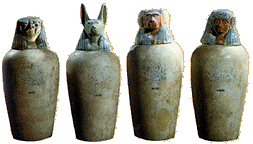
Removal of those parts most subject to putrefaction was the initial step in preparing a corpse for mummification. The embalmers placed the body on a narrow, table-like stand and proceeded to their task. The brain was removed through the nostrils by means of various metal probes and hooks. Such a method necessarily reduced the brain to a fragmentary state, and, as no remains of it are associated with mummies, we may assume that it was discarded. An incision was then made in the left flank of the body to permit removal of the viscera, with the exception of the heart, which was left in the body.
The liver, the lungs, the stomach, and the intestines were each placed in a separate jar, the Canopic Jars , and consigned to the protection of a particular divinity.

Next came the preservation of the body itself. This was accomplished in a manner somewhat similar to that of drying fish. But instead of common salt, natron, a mixture of sodium carbonate and sodium bicarbonate, with sodium chloride (common salt) and sodium sulphate as impurities, was used. Natron occurs in Egypt in a few places. Water containing natron in solution comes to the surface and is evaporated, leaving the natron as surface deposits.
Small parcels of natron wrapped in linen were placed inside the body. The outside was covered with loose natron or packages of linen-wrapped natron. The dry atmosphere of Egypt accelerated the desiccation process. After the body moisture had been absorbed by the natron, the packs were removed and the corpse was given a sponge bath with water. The skin was anointed with coniferous resins, and the body cavity was packed with wads of linen soaked in the same material. The body was then ready to be bound into that compact bundle we know as a mummy.
Only linen was used in the wrapping. To give a more natural appearance, linen pads were placed in the hollows caused by the drying. The arms and legs, sometimes even the fingers and toes, were bandaged separately. Then some twenty or more layers of alternating shrouds and bandages were wrapped around the entire body. Between every few layers of linen a coating of resin was applied as a binding agent. The proper wrapping of a mummy required several hundred square yards of linen. The shrouds were sheets six to nine feet square, and the bandages--strips torn from other sheets were from two to eight inches wide and three to twenty feet long. The linen used in wrapping mummies was for the most part not made especially for shrouds but was old household linen saved for this purpose. Often the linen is marked with the name of the former owner, faded from repeated washings. Occasionally bandages bear short religious texts written in ink.
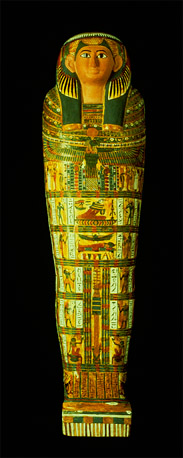
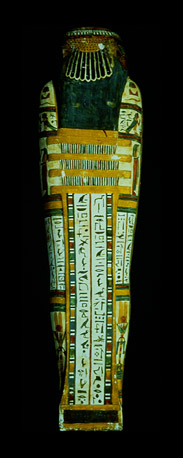
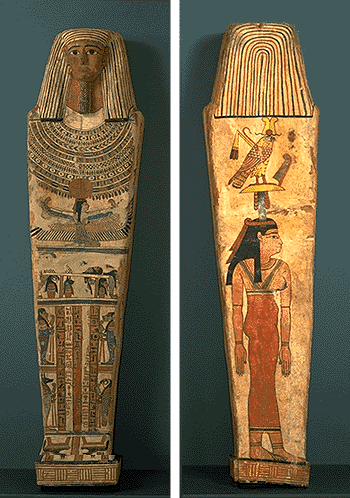

Artists were busy decorating the coffins. The fine painting on the coffins was rarely done directly on the wood, but rather on a smooth plaster coating of whiting and glue over linen glued to the wood. The beautiful colors on many cases are pigments from minerals found in Egypt, often covered with a clear varnish.
Countless other helpers were engaged in constructing and assembling the numerous articles to be deposited with the mummy when it was laid to rest in the tomb.
An extremely important task also undertaken during the seventy days of mummification was the preparation by priests or scribes of magical texts to be placed in the tomb. These texts, now known as the 'Book of the Dead' were written on papyrus rolls varying in length from a few sheets to many sheets, some rolls approaching a length of one hundred feet. Often they were exquisitely illustrated in color. The chapters forming the Book of the Dead contained information necessary to the deceased in overcoming obstacles on his journey and in gaining admittance to the afterworld |
|
|
|
|
|
|
|
|
|
|
|
MUMMIES FROM OTHER COUNTRIES
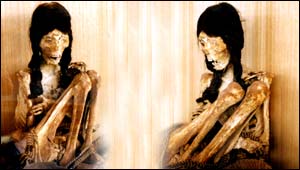
Chinchorro - Mummy from Chile
November 29, 1999 - BBC
Many mummies have been discovered in Northern Chile
Ancient inhabitants of the Andean mountains were infected with the same virus as modern-day Japanese people, suggesting travellers from Asia colonised South America thousands of years ago.
This unusual form of archaeology was carried out by analysing DNA samples taken from the bone marrow of 104 mummies found in Northern Chile.
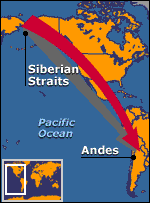
The mummies are believed to be over 1,000 years old and could be as much as 1,500 years old. Two virus samples, from San Pedro de Atacama, provided useful DNA fragments up to 159 base pairs in length.
Kazuo Tajima and his colleagues from the Aichi Cancer Centre Research Institute in Nagoya, Japan, found that fragments were very similar to virus samples taken from living Chilean and Japanese people.
Mongol invasion
This evidence, published in Nature Medicine, adds weight to existing theories that Mongoloid people invaded South America 20,000 years ago, long before the Spanish invaders brought a variety of different infectious diseases to the region.
It also discounts the possibility that the virus was introduced during the European colonisation, 500 years ago.
The virus is associated with adult T-cell leukaemia and other diseases which are today clustered mainly in southwestern Japan and in South America. The new work provides an explanation for the select distribution of the virus but has yet to explain why there is a small population in the Caribbean which also carries it.
The researchers write: "Analysis of these ancient viral sequences could be a useful tool for studying the history of human retroviral infection, as well as human prehistoric migration."
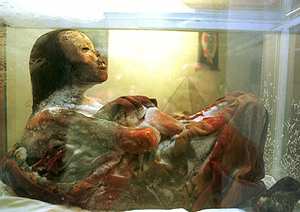
Juanita - Mummy from Peru
Lindow Man - Mummy from England
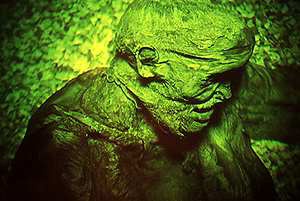
Lindow Man, or Lindow II, was the second body recovered from Lindow Moss (his predecessor--the head which helped induce Peter Reyn-Bardt's murder confession). He was discovered lying between two different layers of peat, suggesting that at the time of deposition the area had been a reasonably deep pool. His arms had badly deteriorated at a much earlier date, probably immediately after his death.
The other parts of his body which were discovered in 1984 include his head, torso and right foot. Then, in 1988, a body originally labeled Lindow IV was found, consisting of the skin of the buttocks, part of the left leg, and both the right thigh and femur of a man; scientists now generally consider this to be just more of Lindow Man, as the pieces from both finds combine to form a single body. Using radiocarbon dating techniques, researchers have placed the body in a date range of 2 BC-AD 119 (Turner, 1995).
Lindow Man, along with the other Lindow bodies, has succeeded in capturing the public's attention through several outstanding physical characteristics which raise implications about his death. He was probably a man of status, judging from evidence of neatly trimmed hair, beard and nails, as well as possible evidence of body paint (although this last item has been hotly debated). It is impossible to tell whether or not he died by drowning since his lungs are no longer intact. All of the damage on his body could possibly (if not probably) have been caused through time by natural elements; however, many people interpret him as a victim of ritual sacrifice.
One of the most common Celtic religious symbols is "triplism;" with Lindow Man, much has been made of his apparent triple death:
1. He seems to have been viciously strangled and garroted-his throat split from one end to the other;
2. His head bears evidence that he was bludgeoned by something like the blunt side of an ax blade;
3. His neck and torso reveal other marks, such as stab wounds, that can be explained by violent events. On top of this, his stomach contents include grains of mistletoe pollen mixed with the remnants of a simple grain cake. This has been taken as a possible Druid link. However, simply too much time has passed to be able to state absolutely under what circumstances Lindow Man met his end.
All of these curiosities have contributed to Lindow Man's enduring celebrity status. Once again, R. C. Turner keenly analyzes the staying power of this bog body's popularity. He comments: "The sense of wonder [bog bodies] conjure up is combined with the feeling that they have in some way cheated death, to live again. The forces behind the violent and often complex deaths they suffered are beyond mere scientific enquiry to convey." (Turner, 1995) |
|
|
|
|
|
|
|
|
|
|
|
Otzi The Iceman
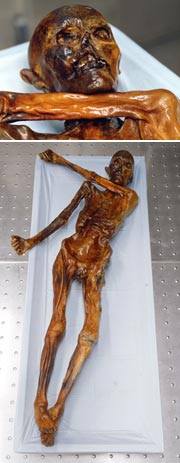
Otzi the Iceman (also spelled Oetzi and known also as Frozen Fritz) is the modern nickname of a well-preserved natural mummy of a man from about 3300 BC, found in 1991 in a glacier of the Otztal Alps, near the border between Austria and Italy. The nickname comes from the valley of discovery. He rivals the Egyptian "Ginger" as the oldest known human mummy, and has offered an unprecedented view on the habits of Chalcolithic (Copper Age) Europeans.
Otzi was found by two German tourists, Helmut and Erika Simon, on September 19, 1991. The body was at first thought to be a modern corpse, like several others which had been recently found in the region. It was roughly recovered by the Austrian authorities and taken to Innsbruck, where its true age was finally discovered. Subsequent surveys showed that the body had been located a few meters inside Italian territory. It is now on display at the South Tyrol Museum of Archaeology in Bozen-Bolzano, Italy.
Scientific analysis
The body has been extensively examined, measured, x-rayed, and dated. Tissues and gut contents were examined microscopically, as was the pollen found on his gear.At the time of his death, Otzi was a 30-to-45-year old man, approximately 160 cm (5'3") tall.
Analysis of pollen and dust grains and the isotopic composition of his teeth's enamel indicate that he spent his childhood near the present village of Feldthurns, north of Bolzano, but later went to live in valleys about 50 km further north.
He had 57 tattoos, some of which were located on or near acupuncture points that coincide with the modern points that would be used to treat symptoms of diseases that Otzi seems to have suffered from, such as digestive parasites and osteoarthrosis. Some scientists believe that these tattoos indicate an early type of acupuncture.
His clothes, including a woven grass cloak and leather vest and shoes, were quite sophisticated.
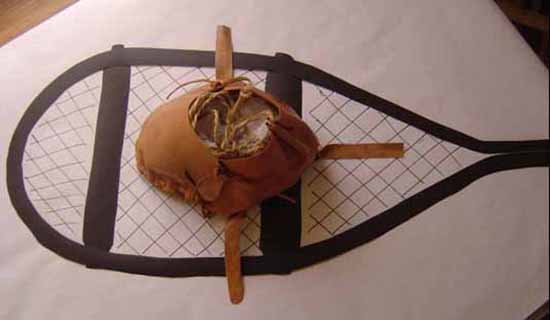
The shoes were waterproof and wide, seemingly designed for walking across the snow; they were constructed using bearskin for the soles, deer hide for top panels, and a netting made of tree bark. Soft grass went around the foot and in the shoe and functioned like warm socks. The shoes have since been reproduced by experts and found to constitute such excellent footwear that there are plans for commercial production.
Other items found with the Iceman were a copper axe with a yew handle, a flint knife with an ash handle, a quiver full of arrows with viburnum and dogwood shafts and flint heads, and an unfinished yew longbow that was taller than he was.
Among Otzi's possessions were two species of polypore mushrooms. One of these (the birch fungus) is known to have antibacterial properties, and was likely used for medical purposes. The other was a type of tinder fungus, included with part of what appeared to be a complex firestarting kit. The kit featured pieces of over a dozen different plants, in addition to flint and pyrite for creating sparks.
In 2004, frozen bodies of three Austro-Hungarian soldiers killed during the Battle of San Matteo (1918) were found. One body was sent to a museum in the hope that research on how the environment affected its preservation will help to find out about Otzi's past and future evolution.
An ancient crime?
Analysis of 謙zi's gut contents showed two meals, one of ibex meat, the second of red deer meat, both consumed with some grain. Pollen in the first meal showed that it had been consumed in a mid-altitude conifer forest.
DNA analysis revealed traces of blood from four other people on his gear: one from his knife, two from the same arrowhead, and a fourth from his coat. A CAT scan revealed that Otzi had what appeared to be an arrowhead lodged in one shoulder when he died, matching a small tear on his coat.
The arrow shaft had been removed, apparently by a companion. He also had bruises and cuts on his hands, wrists, and chest.
From such evidence, and an examination of his weapons, molecular biologist Thomas Loy from the University of Queensland believes that Otzi and one or two companions were hunters who engaged in a skirmish with a rival group. At some point, he may have carried (or been carried by) a companion. Weakened by blood loss, Otzi apparently put down his equipment neatly against a rock, lay down and expired.
Before the latest evidence, it was speculated that, rather than fleeing attackers, he was ritually killed to propitiate a god or gods, or that he was a chieftain and therefore ritually killed to ensure fertility. One of the most fanciful theories was that he was in fact an Egyptian who had been ritually castrated. Later examination, however, revealed that, though shrunken by the mummification, Otzi did in fact possess a penis.
Curse
Seven people loosely related to Otzi's discovery or research have subsequently died, leading some to believe in a curse while others believe that mountain climbers are risk takers and often die early of accidental causes. It should be noted that there are other numerous researchers and scientists working closely with Otzi's body who have not died in the 14 years since his discovery.
1. The "curse" began in 1992 with the death of Dr. Rainer Henn, 64, who was the head of the forensic team who examined the body. He died when his car was in a head-on collision with another vehicle while on his way to give a talk about Otzi.
2. The second "victim" is mountaineer Kurt Fritz, who led Dr. Henn and the others to the iceman's body and later gave tours to the site. Like other experienced climbers, he died in an avalanche at a mountain region he was familiar with.
3. Austrian journalist Rainer Hoelzl was the third "victim". He exclusively covered the removal of the body as part of a one-hour documentary that was shown around the world. But he developed a mystery illness - thought to be a brain tumor - that claimed his life in extreme pain a few months after the programme was shown.
4. The fourth "victim" is the German tourist Helmut Simon, who found the body. The hiker returned to the region to celebrate winning a ?0,000 court battle over rights to the mummy. He set out in fine weather but a blizzard set in and he fell approximately 100 meters into a deep ravine, some 200 kilometers from the place where Otzi perished. He had not signed the court papers so his widow did not get the ?0,000.
5. Dieter Warnecke was the head of the mountain rescue team that searched for Helmut Simon. He died at age 45 of a heart attack less than an hour after Helmut Simon was buried.
6. The 6th victim was archaeologist Konrad Spindler - the leading expert on the 5,300-year-old corpse. The Austrian expert had dismissed the link between the five previous deaths. He declared: "I think it's a load of rubbish. It is all a media hype. The next thing you will be saying I will be next." He died in April 2005 at age 66 of ALS, a pre-existing chronic condition.
7. In October 2005 the "curse" claimed its seventh "victim" - the 63-year old Dr Tom Loy died prior to finishing a book on Otzi. He was the seventh person to die who had been in close contact with the mummy.
The Innsbruck professor Friedrich Tiefenbrunner died during open-heart surgery in January 2005. Tiefenbrunner belonged to Spindler's team and had found a method to protect Otzi's mummy against bacterial and fungal attack. |
|
|
|
|
|
|
|
|
|
|
|
Caucasians in China: The Takla Makan Mummies
Authorities on ancient Chinese civilization have usually considered it to have been completely isolated from European influences for millennia -- a homegrown culture characterized by unique cultural and technological innovations

This classical picture of ancient China will have to be modified after the recent unearthing of mummified Caucasians up to 4,000 years old in China's northwestern province of Xinjiang.
These dried corpses have the long noses, deep-set eyes, and long skulls typical of Caucasians. Some even have blonde hair! Some 113 such corpses have already been excavated at Qizilchoqa, one of four sites discovered so far. It is clear that we are dealing with permanent settlements and not merely a few lost Europeans.
"Besides the riddle of their identity, there is also the question of what these fair-haired people were doing in a remote desert oasis. Probably never wealthy enough to own chariots, they nevertheless had wagons and well-tailored clothes.
Were they mere goat and sheep farmers? Or did they profit from or even control prehistoric trade along the route that later became the Silk Road? If so, they probably helped spread the first wheels and certain metal-working skills into China."
V. Mair, a professor of Chinese at the University of Pennsylvania, has been spearheading the research on these mummies for the U.S. He asserts that, contrary to the general belief, there was a substantial two-way, east-west flow of ideas and inventions beginning at least 3,000-4,000 years ago.

"A Connection should be made here soon regarding the Takla Makan Desert highway from India through China. The timing is in accord with the dispersion from Shinar.
This young girl (and 113 other mummies) has been found along the route. Her mummy is carbon dated to 2000 BC....somewhat accurate. Today this highway is termed the Silk Road. Well his milk road?came along much later around 1260 AD.
......The pattern remains the same folks moved on from Shinar after Babel---east and west. The girl shown below is probably of the families moving east. This of course is coupled to the pyramid construction in that area and my ideas concerning Nimrod ambitions to prevent another destruction of mankind by God via global hydraulic inundation."....Dr. Cliff Paiva, Missile Defense Physicist

Once in a while, however, there truly is a dash of Hollywood-style adventure, as Berkeley archaeologist Jeannine Davis-Kimball discovered during the summer of 1997. On a research expedition to western China, Davis-Kimball and two colleagues found themselves wrapped up in a remarkable ancient mystery spiked with modern day political intrigue.
They were investigating the mummies of the Takla Makan Desert, corpses so well preserved under the arid sands that the trace of a tear still can be seen streaking the face of a child buried 4,000 years ago.
The condition of the mummies, excavated at various sites since the early 1900s, surprised the scientists who first found them. But far more startling was the realization that these bodies, buried millennia ago in western China, are Caucasian.
They have blond, brown and red hair, prominent noses and deep- set eyes. Some are nearly six feet tall. Buried along with them were textiles woven in plaid patterns strikingly similar to those of ancient European fabrics. Tests on one mummy linked it to a European genetic group

This caused a clamor in scientific circles. Conventional wisdom has long been that Western people didn't arrive in China until the establishment of the Silk Road, about 2,000 years ago. Chinese scholars have claimed, and Western scholars have agreed, that Chinese culture evolved in isolation, apart from the influence of Europe
The Caucasian mummies of the Takla Makan proved otherwise, indicating that Europeans forged eastward thousands of years before anyone thought and built a thriving agricultural society in what's now China's Xinjiang Province
Davis-Kimball and her team, with support from the PBS program "Nova," went to Xinjiang to find out just who the mummy people were, and what became of them.
But they soon discovered that not everyone wants that information made known. Proof that Caucasians were living in the region 4,000 years ago clearly refutes China's claim of historical sovereignty there -- and, more important, challenges its hold on the oil-rich province of Xinjiang.
"There's oil down there," Davis-Kimball says. "That's the reason it has to be part of China."
The people native to this area of central Asia are a Turkic ethnic group called Uighurs (WE-gurs). They trace their ties to the region back to around 800 A.D., when their Turkic ancestors moved there and, anthropologists believe, mixed with a people known as the Tocharians.
The Tocharians, who were Buddhists, are thought to have built and ruled a string of cities along the central Asian stretch of the Silk Road. Study of Tocharian manuscripts has revealed that they used a language closely related to Celtic and Germanic tongues; their paintings reveal them to have been a fair-haired, blue-eyed people.
These distinctive characteristics have caused many scholars to link them with the mummy people, who predated them.
Here's where the story gets political. The Uighur majority in Xinjiang now chafes under Chinese rule. There were Uighur uprisings in 1990 and '97, which were summarily crushed by the Chinese Army. To strengthen its hand in the region, the Chinese government has flooded Xinjiang with some 6 million ethnic Han Chinese.
Though the region contains one-third of China's oil reserves, 95 percent of the Uighur population lives in poverty. The Uighurs protest that China has polluted their homeland with industrial toxics and radiation (this is where China couducts its nuclear tests).
China has responded harshly to the dissent. Amnesty International reports that "a pattern of human rights violations has emerged in Xinjiang since 1989."
[ |
Rate
-
1
View Rating Log
-
|
|
|
|
|
|
|
|
|
|
|

China supports it claim to Xinjiang with a myth promulgated since Mao took control of the region in the '40s: that China developed in isolation and that this area has always been part of China -- even though the name Xinjiang means "new territory."
Uighurs have seized upon the mummy pople as proof that their homeland is historically distinct from China. When Davis-Kimball went to Xinjiang she stepped into what is lterally a battle over the area's history, with a mummies at the center.
"They were Caucasoid," David-Kimball says. "This is a no-no for Beijing."
Such a "no-no" that the government has long been loath to allow foreign researchers into the region. Though the mummies were discovered at the beginning of this century, it has been hard to get access to them for the past few decades. More than 30 camera crews had applied to document the story of the mummies and were rejeced before the Chinese government gave the go-ahead to a joint project of "Nova" and England's Channel 4.
Throughout their stay, the team of Davis-Kimball, China historian Victor Mair and forensic anthropologist Charlotte Roberts were closely monitored by Chinese officials. The officials even went so far as to plan an elaborate hoax to mislead them, Davis-Kimball says.
On a grave dig supervised by government chaperones, the team was led to an obviously disturbed tomb that comtained a mummy that had been neatly decapitated. Davis-Kimball and the others concluded that the government had cut the mummy's head off to prevent the team from capturing a Caucasian face on film.
"They had taken the head off so that we would not photograph the Indo- European head, "Davis-Kimball says.
The team had seen the same mummy, intact, along with several others in the back room of a small local museum a short time before the sham excavation.
Inn the Nova program -- entitled "Mysterious Mummies of China" -- Mair says he noticed fungal growth on the corpse that indicated the body had been recently moved. (The office of the Chineses Consulate did not respond to requests for a response to these charges.)
The team also had trouble getting into some of the regional museums, where many of the hundreds of mummies that have been unearthed are stored. Often, Chinese officials would give them permission to visit, only to change their minds soon after. "We were on this yo-yo all the time," Davis-Kimball says. "We never knew what was going to happen next."
So Davis-Kimball and colleagues resorted to a little Indiana Jones-style subterfuge of their own. With the help of a sympathetic local scholar, they snuck into one key museum at midnight, avoiding the scrutiny of wary Chinese officials.
"I kept thinking, how terrible that we had to stay up all night just to photograph something that scientists should be able to study," she says.
Davis-Kimall has made her mark in the field of archaeology with a bold, no-nonsense approach. A silver-haired woman who's comfortable in jeans and a sweatshirt (but would rather not discuss her age), she entered the scholarly world late in life, after raising six children and working as a nurse and a convalescent-hospital administrator.
......Since the 1960s the concept of cultural diffusion has been downplayed as an explanation for similarities shared by distantly separated societies. The politically correct philosophy has been that far-flung societies must have evolved independent of one another.
Finds such as the Takla Makan mummies are now forcing a reexamination of diffusionism. Archaeologists have discovered evidence that whelled wagons were first brought to China from the West thousands of years ago. Among the colorful woven clothing found in the mummies' graves are hats identical to ancient hats found in Austria and southern China.
The "Nova" program speculates that the mummy people originated in Eastern Europe, near the Black Sea. This conclusion is based partly on some striking petroglyphs found on a massive 500-foot-tall rock outcropping. The carvings - which seem to show a fertility dance, a crucial concern for ancient people with infant mortality rates of 33 percent or higher - are distinctive for their triangular torsos and 90-degree arm positions. |
Rate
-
1
View Rating Log
-
|
|
|
|
|
|
|
|
|
|
|
Red Headed Mummies PERU
Below: A red-haired mummy recovered from the Nevado Ampato, Peru, in the mountains near the famous Machu Picchu mountaintop fortress. Dated at circa 1400 AD, this may even have been one of the red-haired Incas that the Spaniards reported seeing
Some of the mummies were found to have the stiff black hair of the Indians, while others, which have been kept in the same conditions, have red, often chestnut-colored hair, "silky and wavy, as found amongst Europeans, they have long skulls and remarkably tall bodies. Hair experts have shown by microscopic analysis, that the red hair has all the characteristics that ordinarily distinguish a Nordic hair type from that of Mongols or American Indians."

A red-haired mummy recovered from the Nevado Ampato, Peru, in the mountains near the famous Machu Picchu mountaintop fortress. Dated at circa 1400 AD, this may even have been one of the red-haired Incas that the Spaniards reported seeing

The sadly desecrated cemetery of Chaucilla, near Nazca, has dozens of ancient red-haired corpses jutting out of their open graves, mute testimony to Peru's ancient White past

Paracas mummy, in its sand grave, with hair well preserved and doliocranicial skull clearly visible. (Photo: JD, 2002)

Chaucilla, Peru. |
|
|
|
|
|
|
|
|
|
|
|
more mummies.....

One of the most remarkable finds from the Upper Paleolithic era is this clothed adult White male, discovered in Sungir, Russia, buried some 25,000 years ago. This was the type of person who created the first known inklings of White civilization of the present interglacial period starting approximately 40,000 BC. The intricacy of the bead work and material with which the corpse was buried is evidence that White Upper Paleolithic man was at this stage already fairly advanced - |
|
|
|
|
|
|
|
|
|
|
|
more mummies...

In ancient times, Nile crocodiles warmed themselves along the river bank, basking in the Egyptian sunshine. Once regarded as sacred animals, crocodile mummies are preserved in the chapel of Hathor located to the right of the temple entrance. Because of its proximity to the river, the temple has suffered damage from the Nile floodwaters and the Forecourt has been washed away. |
|
|
|
|
|
|
|
|
|
|
|
The Mummies of Mammoth Cave
Little Alice Mummy

Discovered in 1875 in Salts Cave, Kentucky. Shown intermittently at Mammoth Cave from about 1890 to 1960.
Drawing by Marilyn DeLuerentis.
Smaller than Fawn Hoof Mummy , naturally mummified by the dryness of the cave atmosphere.
Height approximately 3 1/2 feet
Note the size of head and length of neck.
Carbon dating, dates this mummy to have lived possibly back 3-4,000 years ago, pre-existing the
Native Woodland Indians.
Other researchers have dated the mummy to only being 2,000 years old.
To make matters more confused, Little Alice is now presumed to not be a girl, but a young boy of 9 years old. Others have said 12 years old.
But if you look at the picture as to the features, the features do not appear to be that of a child, but more of a matured person.
The mummy was also found thousands of feet underground in the tunnel system. What would a 9 year old child be taken down there to be buried or have gone down there to die? Could there be another mystery lying here besides sex and age.
The Park Rangers say that all these mummies have been re-buried some place in the cave system of Mamoth, but refuse to give out the location. The location of burial is to remain a secret.
From material gathered around the mummy we can safely say this race of People , whoever they were, were intelligent and civilized.
Fawn Hoof Mummy

This is the mummy that put Mammoth Cave on the map.
Photograph made at Washington D.C., prior to 1896.
Discovered in 1813 by miners mining for saltpetre from the Kentucky Caves. Found in Short Cave. Worker had struck a flat rock beneath the clay floor. The rock was lifted and beneath was a small crypt with above mummy inside.
Body was in a state of perfect preservation and sitting erect with arms folded up and hands laid across the bosom, wrapped with two deer skins to keep hands in position.
Skins were ornamented with the imprints of vines and leaves. Also found within the crypt was a large square woven or knitted sheet.
The hair on the head of the mummy ws cut off within an eighth of an inch of the skin, except near the neck, where it was an inch long. The color of the hair was DARK RED, the teeth white and perfect. The finger and toe nails were perfect and quite long. Features were regular and judged to be female having heighth of close to 6 foot tall.
Skin was darkened but not black in color.
The greatest curiosity was that this mummy seemed to have been mummified or embalmed much like what we would find confined to the Egyptians and had not been encountered before in the Americas untl this discovery, said John Hay Farnham, American Antiquarian Society.
Shape and conformation of the ears were perfectly preserved as well as hands, fingers and toenails. The teeth all in their proper place, the lips though dried, were yet coral in their appearance. Much of the hair was perfect as well as the whole body in general.
Seems though that the feet were small in proportion to her body.
Based on relics found in buriel vault, it seems that she was a woman of importance.
Color of her dried body was liked that of dried tobacco witha yellowish hue.
The Smithsonian Institution received her body in 1876 and body has since been dissected and later lost altogether.
Fortunately the above picture was taken before her desecretion.
Scudder's Mummy
Photo courtesy of the Historical Society of Pennsylvania , PA.
Here we again find a unique coloring to the hair. The scalp was reported to have been covered with sorrel or foxy hair. (red). The skin although dried shows little inury, dusky in color . The teeth are white and sound. Hands and feet slender and delicate.
Was found in 1814, cave in the town of Glasgow, Ky, about 9 feet under the surface. Wrapped in deer skins and articial cloths, found in sitting position about 200 yards from the entrance of the Cave.
"Seems the fabrics appear to be similar to those of the Fegee and Sandwich Islands"
(J.G.Bogert, Esq. )
This mummy was later sold to P.T. Barnum.
Scudder's Mummy

Here we again find a unique coloring to the hair. The scalp was reported to have been covered with sorrel or foxy hair. (red). The skin although dried shows little inury, dusky in color . The teeth are white and sound. Hands and feet slender and delicate.
Was found in 1814, cave in the town of Glasgow, Ky, about 9 feet under the surface. Wrapped in deer skins and articial cloths, found in sitting position about 200 yards from the entrance of the Cave.
"Seems the fabrics appear to be similar to those of the Fegee and Sandwich Islands"
(J.G.Bogert, Esq. )
This mummy was later sold to P.T. Barnum. |
|
|
|
|
|
|
|
|
|
|
|
|
one of my fave subjects nih.... thanks u all for sharing..... |
|
|
|
|
|
|
|
|
|
|
|
...............
Originally posted by Foxey at 5-4-2006 02:59 PM
one of my fave subjects nih.... thanks u all for sharing.....
welcome dear.... i will find more information about mummies all over countries...:tq: |
|
|
|
|
|
|
|
|
|
|
|
Mummy from New Guinea

The ancient Egyptians are the most famous mummy-makers, but they were not the only ancient civilization, or even the first, to preserve their dead. The Chinchorro people of northern Chile developed a mummification process around 5000 B.C., some 2,000 years before the Egyptians. These mummies, the oldest in the world, are nothing like the famous Egyptian figures. The Chinchorros dismembered and disemboweled the body completely, then attached the pieces back together using straw, plant fibers and stick. They then covered this frame with black mud, which they sculpted into a human form with a face and other ornamentation.
The resulting mummies are a strange hybrid of a corpse and a statue. It's unclear what the motivation behind this practice was, but many researchers believe it did not have to do with any concept of an afterlife. The mummies show signs of wear, and even repainting, indicating they were kept in households as statues for some time before being buried. This practice indicates that the mummies were created more for the sake of the deceased's family and friends, rather than for the good of the deceased. The Chinchorro people probably kept the mummies around as a way to honor and remember the dead, to help them mourn the loss.
Some later South-American cultures also produced mummies, both by artificial and natural means. In the mountains of Peru, scientists have uncovered many Incan bodies preserved by the dry atmosphere and extremely cold temperatures. Even though the mummifying agent is completely natural, these mummies are, in a sense, manmade -- they were deliberately bought to the remote location, with the understanding that the bodies would be preserved there. The Incans sacrificed children and took the bodies to these high points as an offering to their gods. |
|
|
|
|
|
|
|
|
|
| |
|